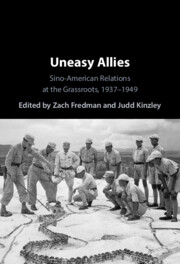Book contents
- Uneasy Allies
- Uneasy Allies
- Copyright page
- Contents
- Figures
- Contributors
- Acknowledgments
- Maps
- 1 Introduction
- Part I An Informal Alliance
- Part II Entanglements of American Empire
- Part III American Power and the New World Order
- Part IV The New Imperialism
- 10 Haydon Boatner and Sino-American Military Cooperation
- 11 Dealing with the Dead in the China-Burma-India Theater
- 12 Qingdao and the Politics of Occupation in Postwar China
- 13 The Debate over ‘Jeep Girls’ in Postwar China
- 14 Smuggling, Military Jurisdiction, and the Remaking of US Empire in Postwar China
- 15 Conclusion
- Bibliography
- Index
11 - Dealing with the Dead in the China-Burma-India Theater
from Part IV - The New Imperialism
Published online by Cambridge University Press: 12 December 2024
- Uneasy Allies
- Uneasy Allies
- Copyright page
- Contents
- Figures
- Contributors
- Acknowledgments
- Maps
- 1 Introduction
- Part I An Informal Alliance
- Part II Entanglements of American Empire
- Part III American Power and the New World Order
- Part IV The New Imperialism
- 10 Haydon Boatner and Sino-American Military Cooperation
- 11 Dealing with the Dead in the China-Burma-India Theater
- 12 Qingdao and the Politics of Occupation in Postwar China
- 13 The Debate over ‘Jeep Girls’ in Postwar China
- 14 Smuggling, Military Jurisdiction, and the Remaking of US Empire in Postwar China
- 15 Conclusion
- Bibliography
- Index
Summary
Focusing on the efforts to recover, repatriate, and rebury thousands of fallen soldiers from the China-Burma-India Theater, this chapter analyzes how the disparate treatment of American bodies and Chinese bodies defined the Sino-American relations in the immediate postwar period. The first part of this chapter examines how well-established institutions, ambulant resources, and cooperative regimes enabled US servicemen to salvage the bodies of American soldiers from distant theaters of war to reinter them in national and private cemeteries on American soil. The second part addresses the struggle of the Chinese government in Nanjing, the Chinese military command in India, and the Chinese communities in Burma to provide proper burials for the dead of the Nationalist expeditionary forces. China lacked the formal institutions and infrastructure to manage war graves in foreign territories, and failed to garner the support of local authorities. When the political chaos of the Chinese Civil War led to the cessation of funding from the Nationalist government, the graves of Chinese soldiers in India and Burma fell into oblivion.
- Type
- Chapter
- Information
- Uneasy AlliesSino-American Relations at the Grassroots, 1937–1949, pp. 194 - 214Publisher: Cambridge University PressPrint publication year: 2024

